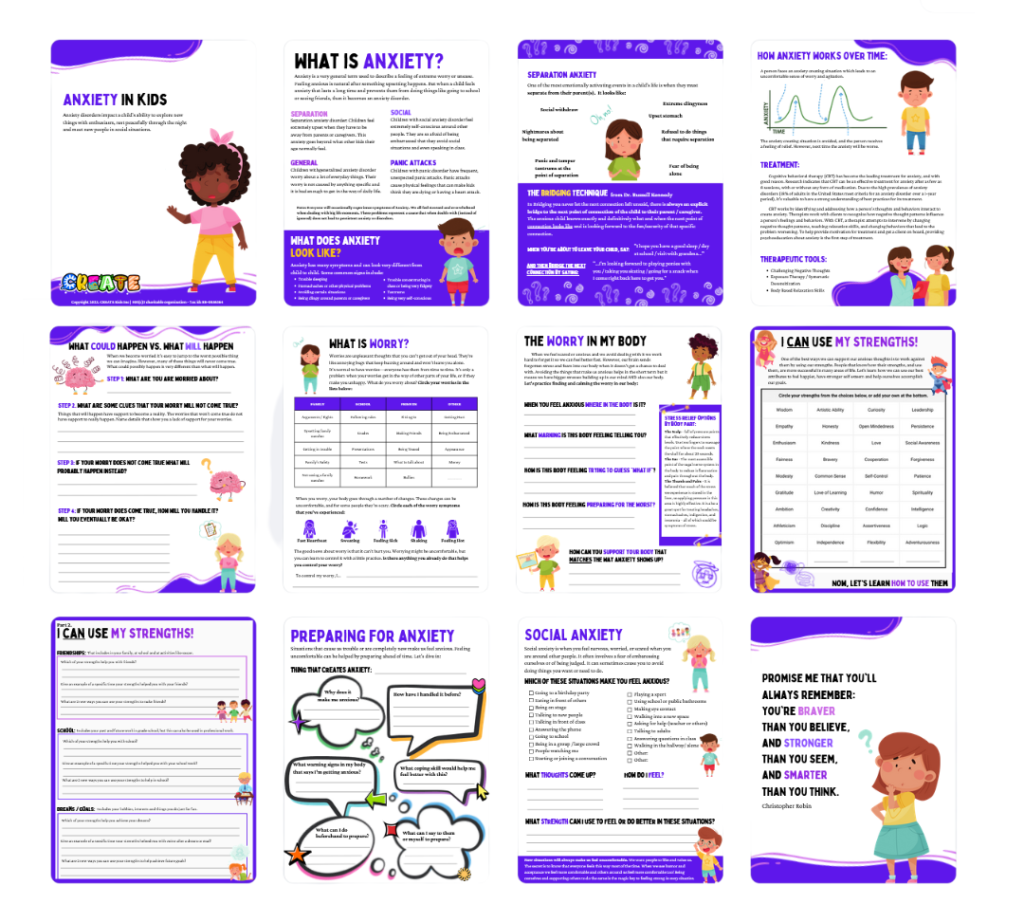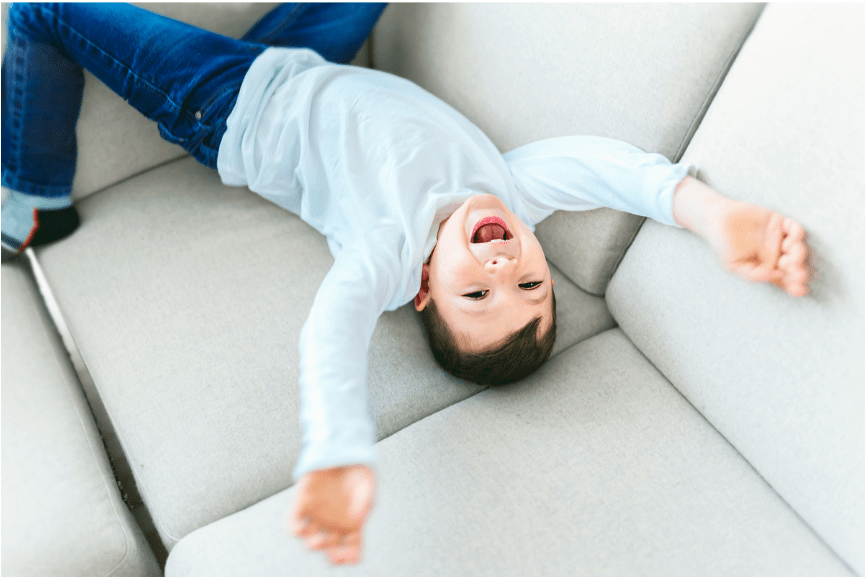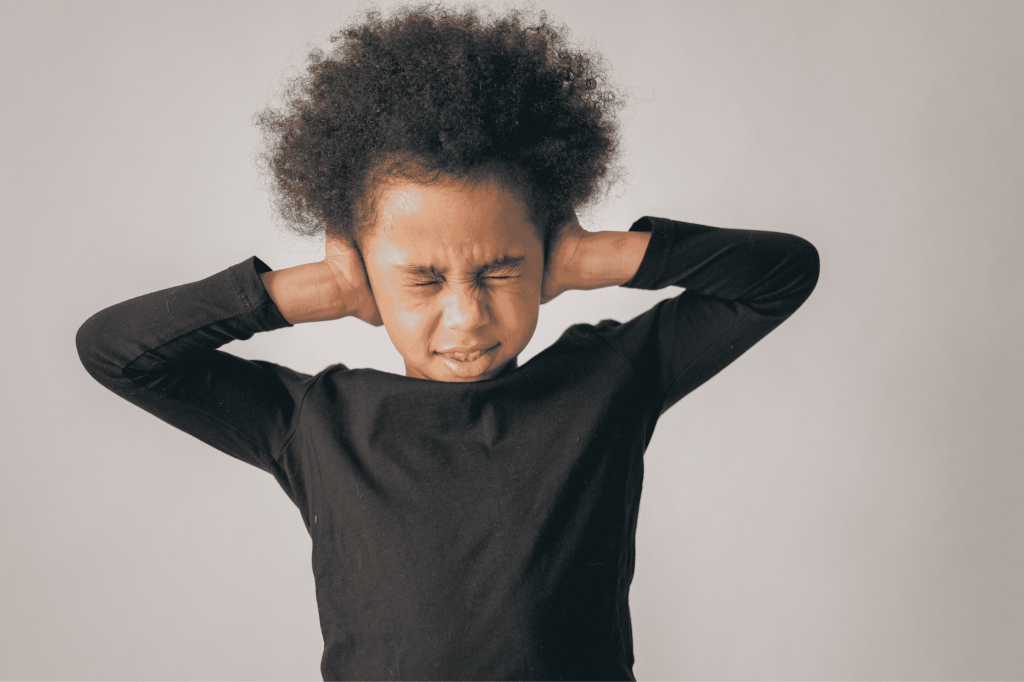Grow. Connect. Learn.
Grab our full guide for Anxious Kids


We want you to feel empowered to support your child through their anxious struggles.
That’s why we developed this thorough guide.
It includes:
- What Anxiety is
- Separation (What it is + Skills)
- How Anxiety grows over time
- What ‘Worry’ is (it’s goal)
- How Worry appears in the body
- Teaching Kids How to Use Their Strengths to Address Anxiety
- Teaching Kids How to Plan For Anxious Experiences
- Social Anxiety (What it is + Skills)
- Scripts for Anxious Kids (Do’s + Don’ts)
It’s our mission to help children become mindful of bodily sensations. This awareness helps reduce the intensity of high emotional arousal significantly!
It is body awareness that helps children become mindful and more in control of the anxiety in their inner and outer worlds.
Pay special attention to our Worry & Anxiety in the Body education and worksheets!
Keep scrolling to start learning right now...
Changes in the Brain:
Brain Differences in Anxiety
Amygdala Hyperactivity: The amygdala, which is responsible for processing emotions like fear and anxiety, tends to be overactive in people with anxiety disorders. This hyperactivity leads to heightened emotional responses and increased sensitivity to potential threats.
Prefrontal Cortex (PFC) Dysfunction: The PFC, which is involved in executive functions such as decision-making, impulse control, and regulation of emotional responses, often shows reduced activity in individuals with anxiety. This can impair the brain’s ability to regulate the heightened emotional responses generated by the amygdala.
Hippocampus Changes: The hippocampus, which is crucial for forming and retrieving memories, can be smaller in people with chronic anxiety. This change is thought to result from the neurotoxic effects of chronic stress hormones like cortisol.
Neurotransmitter Imbalances: Anxiety is associated with imbalances in key neurotransmitters, including serotonin, norepinephrine, and gamma-aminobutyric acid (GABA). These chemicals play crucial roles in mood regulation, arousal, and stress responses.
Insula and Anterior Cingulate Cortex (ACC): The insula and ACC, which are involved in interoceptive awareness (awareness of internal bodily states) and emotional regulation, show altered activity in people with anxiety. These changes contribute to heightened awareness of bodily sensations and increased emotional reactivity.
How Mindset Impacts Their Lived Experience
Constant Worry and Hypervigilance: Individuals with anxiety often experience persistent worry and hypervigilance. They are constantly on the lookout for potential threats, leading to a state of chronic tension and alertness.
Catastrophic Thinking: People with anxiety tend to engage in catastrophic thinking, where they imagine the worst-case scenarios in various situations. This can lead to excessive fear and avoidance behaviors.
Difficulty Concentrating: Anxiety can impair cognitive functions like concentration and memory. The constant state of worry can make it hard to focus on tasks, leading to decreased productivity and increased frustration.
Physical Symptoms: Anxiety often manifests physically, with symptoms such as increased heart rate, muscle tension, sweating, gastrointestinal issues, and dizziness. These physical symptoms can reinforce the feeling that something is wrong, perpetuating the cycle of anxiety.
Avoidance Behaviors: To manage their anxiety, individuals may start avoiding situations, places, or activities that trigger their fear. This avoidance can lead to social isolation and can interfere with daily functioning and quality of life.
Emotional Dysregulation: People with anxiety may struggle to regulate their emotions, experiencing intense and overwhelming feelings of fear, panic, or dread. This can lead to mood swings and a sense of being out of control.
Changes in the Body:

The nervous system of a person with ADHD has fundamental differences that impact how the body experiences the world. These varying impacts can affect the automatic reactions a person has to bodily sensations, new experiences, rejection, frustration as well as the body’s automatic fight-or-flight responses.
Nervous System Differences in Anxiety
Differences in Body Sensations
Increased Physical Arousal:
- Individuals with anxiety often experience heightened physical arousal, which can manifest as increased heart rate, rapid breathing, sweating, and muscle tension. These sensations are part of the body’s preparation for fight/flight responses.
Somatic Symptoms:
- Anxiety can lead to various somatic symptoms such as headaches, gastrointestinal issues (e.g., nausea, diarrhea, or irritable bowel syndrome), dizziness, and chronic pain. These symptoms are often a result of the body’s prolonged stress response.
Hyperawareness of Bodily Sensations:
- People with anxiety may become hyperaware of normal bodily sensations, interpreting them as signs of a serious medical condition. This hyperawareness can amplify anxiety and create a feedback loop of increasing worry and physical symptoms.
Sleep Disturbances:
- Anxiety often disrupts sleep, leading to insomnia, restless sleep, or difficulty falling asleep. Poor sleep further exacerbates anxiety and its physical symptoms.
Fatigue and Exhaustion:
- Chronic anxiety can lead to persistent fatigue and a feeling of exhaustion, even after minimal physical exertion. The constant state of alertness drains energy reserves, leaving individuals feeling worn out.
Differences in Fight/Flight Responses
Chronic Activation of the Fight/Flight Response:
- In people with anxiety, the fight/flight response can be triggered by minor stressors or even without an apparent trigger. This leads to a state of chronic hyperarousal, where the body is always prepared for a perceived threat.
Difficulty Returning to Baseline:
- After the fight/flight response is activated, individuals with anxiety often struggle to return to a calm baseline state. The PNS, which helps to calm the body, is less effective in these individuals, prolonging the state of arousal.
Exaggerated Responses to Stress:
- The nervous system’s response to stressors can be exaggerated, leading to intense physical and emotional reactions that may seem disproportionate to the situation.
Avoidance Behavior:
- To avoid triggering the fight/flight response, individuals with anxiety may engage in avoidance behaviors, steering clear of situations or places that they perceive as threatening. This can lead to social isolation and limitations in daily functioning.
Heightened Startle Response:
- Individuals with anxiety often have a heightened startle response, reacting more strongly to sudden noises or unexpected events. This is a result of the nervous system being in a constant state of vigilance.
Differences in Body Sensations and Experiences
Increased Physical Arousal:
- Individuals with anxiety often experience heightened physical arousal, which can manifest as increased heart rate, rapid breathing, sweating, and muscle tension. These sensations are part of the body’s preparation for fight/flight responses.
Somatic Symptoms:
- Anxiety can lead to various somatic symptoms such as headaches, gastrointestinal issues (e.g., nausea, diarrhea, or irritable bowel syndrome), dizziness, and chronic pain. These symptoms are often a result of the body’s prolonged stress response.
Hyperawareness of Bodily Sensations:
- People with anxiety may become hyperaware of normal bodily sensations, interpreting them as signs of a serious medical condition. This hyperawareness can amplify anxiety and create a feedback loop of increasing worry and physical symptoms.
Sleep Disturbances:
- Anxiety often disrupts sleep, leading to insomnia, restless sleep, or difficulty falling asleep. Poor sleep further exacerbates anxiety and its physical symptoms.
Fatigue and Exhaustion:
- Chronic anxiety can lead to persistent fatigue and a feeling of exhaustion, even after minimal physical exertion. The constant state of alertness drains energy reserves, leaving individuals feeling worn out.
Differences in Fight/Flight Responses
Chronic Activation of the Fight/Flight Response:
- In people with anxiety, the fight/flight response can be triggered by minor stressors or even without an apparent trigger. This leads to a state of chronic hyperarousal, where the body is always prepared for a perceived threat.
Difficulty Returning to Baseline:
- After the fight/flight response is activated, individuals with anxiety often struggle to return to a calm baseline state. The PNS, which helps to calm the body, is less effective in these individuals, prolonging the state of arousal.
Exaggerated Responses to Stress:
- The nervous system’s response to stressors can be exaggerated, leading to intense physical and emotional reactions that may seem disproportionate to the situation.
Avoidance Behavior:
- To avoid triggering the fight/flight response, individuals with anxiety may engage in avoidance behaviors, steering clear of situations or places that they perceive as threatening. This can lead to social isolation and limitations in daily functioning.
Heightened Startle Response:
- Individuals with anxiety often have a heightened startle response, reacting more strongly to sudden noises or unexpected events. This is a result of the nervous system being in a constant state of vigilance.

What Living with Anxiety Looks Like:
Persistent Fear and Tension:
- Living with anxiety means living with a persistent sense of fear and tension. Everyday situations can feel threatening, and the person may always feel on edge, waiting for something bad to happen.
Impact on Relationships:
- Anxiety can strain personal relationships. The constant need for reassurance, avoidance behaviors, and irritability can affect interactions with family, friends, and colleagues.
Challenges in Daily Life:
- Routine activities like going to work, attending social events, or even leaving the house can become daunting tasks. The fear of anxiety symptoms arising in public can lead to significant lifestyle restrictions.
Health Concerns:
- Chronic anxiety can lead to long-term health issues such as cardiovascular problems, weakened immune system, and gastrointestinal disorders. The constant release of stress hormones can take a toll on physical health.
Supporting children with ADHD:
Anxious brains may linger on unpleasant issues, leaving somatic discomforts heightened. Somatic therapy for people with Anxiety begins with learning to be mindful of bodily sensations, which can eventually help reduce the intensity of high emotional arousal.
Somatic or body-based coping skills can be highly effective for individuals with Anxiety in managing their symptoms and regulating their nervous system. These techniques focus on using physical and sensory experiences to create a sense of calm, improve focus, and enhance emotional regulation. Here are several body-based coping skills that can help:

1. Grounding Techniques
Technique: 5-4-3-2-1 Grounding Exercise
Description: This technique helps individuals reconnect with the present moment by engaging their five senses, which can be particularly useful in reducing anxiety and feelings of disconnection often associated with depression.
Steps:
- See: Identify five things you can see around you.
- Touch: Identify four things you can touch and describe their texture.
- Hear: Identify three sounds you can hear.
- Smell: Identify two things you can smell.
- Taste: Identify one thing you can taste.
Benefits: This exercise can help calm the nervous system and promote a sense of stability and presence.
2. Breathing Exercises
Technique: Diaphragmatic Breathing
Description: Also known as deep belly breathing, this technique helps activate the parasympathetic nervous system, promoting relaxation and reducing stress.
Steps:
- Sit or lie down in a comfortable position.
- Place one hand on your chest and the other on your abdomen.
- Inhale deeply through your nose, allowing your abdomen to expand while keeping your chest relatively still.
- Exhale slowly through your mouth, feeling your abdomen fall.
- Repeat this process for 5-10 minutes, focusing on the rise and fall of your abdomen.
Benefits: Diaphragmatic breathing can reduce cortisol levels, lower heart rate, and help manage anxiety and depressive symptoms.
3. Progressive Muscle Relaxation (PMR)
Technique: Progressive Muscle Relaxation
Description: PMR involves systematically tensing and then relaxing different muscle groups in the body, which can help reduce physical tension and promote relaxation.
Steps:
- Find a comfortable position, either sitting or lying down.
- Starting with your feet, tense the muscles as tightly as possible for 5-10 seconds.
- Release the tension and focus on the sensation of relaxation for 10-20 seconds.
- Move up to the next muscle group (calves, thighs, abdomen, etc.) and repeat the process.
- Continue through all major muscle groups up to the face and head.
Benefits: PMR can help individuals become more aware of physical sensations, reduce overall muscle tension, and promote a sense of calm and relaxation.
4. Mindful Movement
Technique: Gentle Yoga or Tai Chi
Description: Mindful movement practices like yoga or Tai Chi involve slow, deliberate movements combined with breath control and mindfulness. These practices can improve body awareness, flexibility, and relaxation.
Steps:
- Choose a gentle yoga or Tai Chi routine that focuses on slow, mindful movements.
- Begin with deep breathing to center yourself.
- Move through the routine, focusing on the sensations in your body and the rhythm of your breath.
- Pay attention to how your body feels in each pose or movement, making adjustments to stay comfortable.
- End with a few minutes of seated or lying down meditation, focusing on your breath and the sensations in your body.
Benefits: These practices can enhance body awareness, reduce stress, and promote a positive relationship with the body. They also help improve balance, flexibility, and overall physical health.
5. Somatic Experiencing (SE)
Technique: Body Scanning
Description: Body scanning involves mentally scanning your body for areas of tension and consciously relaxing those areas. This can help increase awareness of physical sensations and reduce tension.
Steps:
- Find a quiet, comfortable place to sit or lie down.
- Close your eyes and take a few deep breaths to center yourself.
- Start at the top of your head and slowly work your way down to your toes, mentally scanning each part of your body.
- As you scan each area, notice any tension or discomfort.
- Breathe into the area of tension and imagine it releasing with each exhale.
- Continue scanning your body until you reach your toes, taking your time and focusing on relaxation.
Benefits: Body scanning can help increase awareness of physical sensations, promote relaxation, and reduce stress and anxiety.

Helping Families Dealing with Anxiety
Extra Support for Children with Anxiety
CREATE uses a family first approach that focuses on building connection between parent and child. We combine that with a body centered framework that aims to build a child’s capability to identify, sit with and process strong feelings.
Contact us to work with our therapist if you are interested in addressing your child’s specific needs with our approach. We offer one-on-one therapy, homework and school support, activities focused on improving the family and more.
